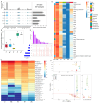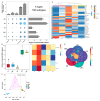Metagenomic Insights into the Diverse Antibiotic Resistome of Non-Migratory Corvidae Species on the Qinghai-Tibetan Plateau
- PMID: 40284799
- PMCID: PMC12031176
- DOI: 10.3390/vetsci12040297
Metagenomic Insights into the Diverse Antibiotic Resistome of Non-Migratory Corvidae Species on the Qinghai-Tibetan Plateau
Abstract
Antibiotic resistance represents a global health crisis with far-reaching implications, impacting multiple domains concurrently, including human health, animal health, and the natural environment. Wild birds were identified as carriers and disseminators of antibiotic-resistant bacteria (ARB) and their associated antibiotic resistance genes (ARGs). A majority of studies in this area have concentrated on migratory birds as carriers for the spread of antibiotic resistance over long distances. However, there has been scant research on the resistome of non-migratory Corvidae species that heavily overlap with human activities, which limits our understanding of antibiotic resistance in these birds and hinders the development of effective management strategies. This study employed a metagenomics approach to examine the characteristics of ARGs and mobile genetic elements (MGEs) in five common Corvidae species inhabiting the Qinghai-Tibetan Plateau. The ARGs were classified into 20 major types and 567 subtypes. Notably, ARGs associated with multidrug resistance, including to macrolide-lincosamide-streptogramins, tetracyclines, beta-lactam, and bacitracin, were particularly abundant, with the subtypes acrB, bacA, macB, class C beta-lactamase, and tetA being especially prevalent. A total of 5 types of MGEs (166 subtypes) were identified across five groups of crows, and transposase genes, which indicated the presence of transposons, were identified as the most abundant type of MGEs. Moreover, some common opportunistic pathogens were identified as potential hosts for these ARGs and MGEs. Procrustes analysis and co-occurrence network analysis showed that the composition of the gut microbiota shaped the ARGs and MGEs, indicating a substantial association between these factors. The primary resistance mechanisms of ARGs in crows were identified as multidrug efflux pumps, alteration of antibiotic targets, and enzymatic inactivation. High-risk ARGs which were found to potentially pose significant risks to public health were also analyzed and resulted in the identification of 81 Rank I and 47 Rank II ARGs. Overall, our study offers a comprehensive characterization of the resistome in wild Corvidae species, enhancing our understanding of the potential public health risks associated with these birds.
Keywords: antibiotic resistance genes; avian microbiome; corvidae; gut microbiota; metagenomic sequencing.
Conflict of interest statement
The authors declare no competing financial interests or personal relationships that could have appeared to influence the work reported in this paper.
Figures









Similar articles
-
A comparison of antibiotic resistance genes and mobile genetic elements in wild and captive Himalayan vultures.PeerJ. 2024 Jul 9;12:e17710. doi: 10.7717/peerj.17710. eCollection 2024. PeerJ. 2024. PMID: 39006014 Free PMC article.
-
Antimicrobial resistance and its risks evaluation in wetlands on the Qinghai-Tibetan Plateau.Ecotoxicol Environ Saf. 2024 Sep 1;282:116699. doi: 10.1016/j.ecoenv.2024.116699. Epub 2024 Jul 8. Ecotoxicol Environ Saf. 2024. PMID: 38981389
-
Metagenomic analysis reveals the microbiome and resistome in migratory birds.Microbiome. 2020 Mar 2;8(1):26. doi: 10.1186/s40168-019-0781-8. Microbiome. 2020. PMID: 32122398 Free PMC article.
-
Profiles of Microbial Community and Antibiotic Resistome in Wild Tick Species.mSystems. 2022 Aug 30;7(4):e0003722. doi: 10.1128/msystems.00037-22. Epub 2022 Aug 1. mSystems. 2022. PMID: 35913190 Free PMC article. Review.
-
The Petri dish under the ice: permafrost pathogens and their impact on global healthcare and antibiotic resistance.Ann Med Surg (Lond). 2024 Oct 11;86(12):7193-7201. doi: 10.1097/MS9.0000000000002650. eCollection 2024 Dec. Ann Med Surg (Lond). 2024. PMID: 39649926 Free PMC article. Review.
References
-
- Islam M.A., Bose P., Rahman M.Z., Muktaruzzaman M., Sultana P., Ahamed T., Khatun M.M. A review of antimicrobial usage practice in livestock and poultry production and its consequences on human and animal health. J. Adv. Vet. Anim. Res. 2024;11:675–685. doi: 10.5455/javar.2024.k817. - DOI - PMC - PubMed
Grants and funding
LinkOut - more resources
Full Text Sources

